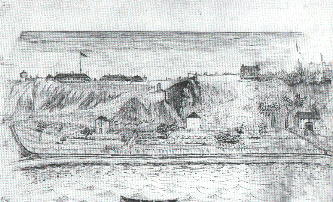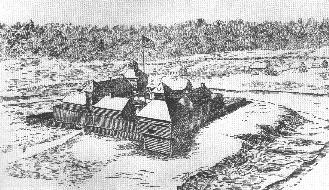Our sites:
Home
of
Access Heritage Inc (formerly The Discriminating General)
Heritage Film Services: Bringing History to Life
The Napoleonic Wars Collection
Military Music Sound Clip Gallery
Products and Services:
British Army Products 1793-1815
British Army Products 1816-1856

Articles - Reenactments and Units - Book Reviews - Quizzes - Replicas - Links - Chart of British Regiments - Sound Clips - Prints for Sale - Animated GIF Battles - Chronology of Events - Video Clips
Battles
of Michilimackinac and Fort Dearborn, 1812
by R. Taylor

Michilimackinac Island
Soon
after the outbreak of war, the British forces on St Joseph's Island moved
toward the American held Mackinac Island. The British forces consisted of
45 regular soldiers under the command of Captain Roberts plus 180 Canadian
Voygeurs from the North West Company and 400 Indians.
On the night of July 16th the British landed at a sheltered place on
the shore of the island and the next morning were in position on the hill
above the fort with cannon and muskets aimed down into it.
Lieutenant Porter Hanks, the American commander who had never been
warned by his own government that they were declaring war, had 61 regular
soldiers in the sturdy fort. Lieutenant Hanks had a choice, he could fight
to the last man and become a hero or surrender. If it were a matter of
facing just the 45 British regulars he might have done that. But he was
also facing the Indian warriors whose savagery is said to be without
limits, and therefore he may be fighting to not only the last man but the
last women and child as well.
The American commander had no choice but to surrender and agree to the
British terms, one of which was that his troops be paroled to their homes
and not take part in the war until they can be exchanged for British
soldiers who have been captured.
Lieutenant Hanks is amazed "War! what War?"
The date is July 17th a full month has passed since the United States
declared war on Great Britain, but this is the first Lieutenant Hanks has
heard of it.
The American Government will pay a big price for not warning all their
forces that they had declared war. This bloodless battle is also one of
the most significant. The news of the capture of Michilimackinac Island
will touch off a chain of events that will frustrate the Americans in
their attempt to seize British North America, an enterprise that most of
them believe to be, in Thomas Jefferson's much quoted phrase, "A mere
matter of marching."
Fort Dearborn

As word spread of the British victory at Mackinac, the Indians began to gather around other American forts. They gathered at what is now Chicago near Fort Dearborn, where Captain Nathan Heald commanded the small garrison of about 50 men. In response to the order from General Hull to withdraw to Fort Wayne, he first distibuted much trade goods to the Indians in return for promises of safe conduct, and then set out on the morning of August 15th with his soldiers, a handful of local settlers and militia, and their families. At the head of the column was Captain William Wells, a veteran Indian fighter who served under Anthony Wayne; he had come from Fort Wayne with 30 friendly Miami braves to lead the way back. The garrison did not trust the Indians; prophetically the fife and drums played the funeral march as they started out.
The hostile Indians waited in ambush behind some nearby sand dunes. Wells saw them and gave the alarm, just before an attack that killed about half the regulars. The others rallied and charged them driving them back across the dunes- but in the process became separated from the baggage train where most of the women and children rode. The Chicago militia guarded that part of the column. Militia and families were quickly overwhelmed and most of them slaughtered. In the fight Wells was killed, scalped, and his body was beheaded. His Miami Indians had long since fled. The remaining soldiers held a parley in which the hostile Indians promised that if the Americans surrendered none of them would be harmed. They agreed. and as they were led back to Fort Dearborn they passed the baggage train where they saw the women and children "lying naked with principally all their heads off."
Once back at the fort, the Indians soon began to torture and kill their captives. The few survivors were taken away in all directions after the departing Indians had burned the fort. Both Captain and Mrs. Heald were badly wounded, but survived the battle, ending it in the hands of different groups of Indians. The family of John Kinzie, a nearby fur trader the Indians considered a neutral, waited in a boat near shore in case they had to flee. Mrs. Kinzie saw Mrs. Heald's predicament and sent one of her husband's clerks to trade an old mule and some whiskey to the band holding her, so that they would transfer to the one that held her husband. Eventually the Healds escaped and after a three hundred mile voyage in a canoe made their way to Mackinac. There Captain Roberts, the British commander, gave them a small sailboat and sent them to Detroit.

Copyright: Unless otherwise noted, all information, images, data contained within this website is protected by copyright under international law. Any unauthorized use of material contained here is strictly forbidden. All rights reserved.
